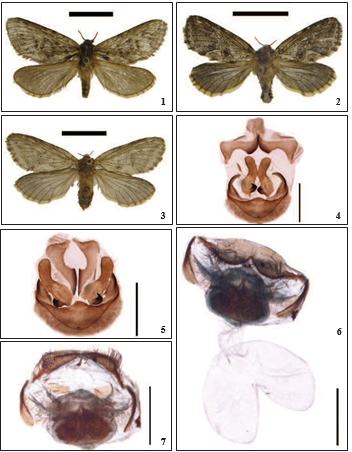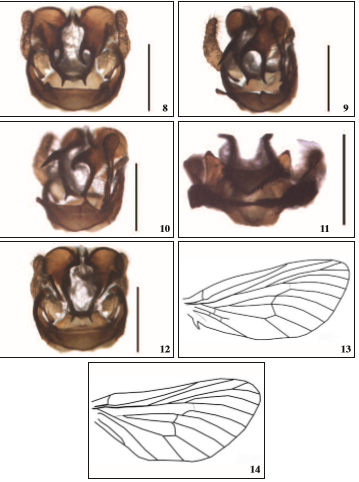

ThitarodesViette, 1968: a new generic synonym and a new species from China (Lepidoptera: Hepialidae)
ThitarodesViette, 1968: una nueva sinonimia genérica y una nueva especie de China (Lepidoptera: Hepialidae)
ThitarodesViette, 1968: a new generic synonym and a new species from China (Lepidoptera: Hepialidae)
SHILAP Revista de lepidopterología, vol. 44, núm. 175, 2016
Sociedad Hispano-Luso-Americana de Lepidopterología
Recepción: 03 Noviembre 2015
Aprobación: 06 Enero 2016
Abstract: Parahepialus Zou & Zhang, 2010 is synonymized with Thitarodes Viette, 1968. Thitarodes quadrata Jiang, Li, Li, Li & Han, sp. n. is described from Sichuan, China. Illustrations of the adults and the genitalia are given for the type species of Parahepialus and the new species.
Keywords: Lepidoptera, Hepialidae, Thitarodes, new generic synonym, new species, China.
Resumen: Parahepialus Zou & Zhang, 2010 es sinonimizado con Thitarodes Viette, 1968. Se describe Thitarodes quadrata Jiang, Li, Li, Li & Han, sp. n. de Sichuan, China. Se dan ilustraciones del adulto y de la genitalia para la especvie tipo de Parahepialus y de la nueva especie.
Palabras clave: Lepidoptera, Hepialidae, Thitarodes, nueva sinonimia genérica, nueva especie, China.
Introduction
The genus Thitarodes was established by VIETTE (1968) on the basis of Hepialus armoricanus Oberthür, 1909 from Tibet, China. The main diagnostic character of the genus was the presence of an acute process protruding from the basal part of the valva of the male genitalia (VIETTE, 1968). NIELSEN et al. (2000) gave a world checklist of Hepialidae. In their paper, 51 species are listed in Thitarodes, most of them being mainly distributed in Eastern Asia. Besides, Forkalus Chu & Wang, 1985 was treated as a junior synonym of Thitarodes Viette, 1968, and most species which were described under the genus Hepialus Fabricius, 1775 were transferred to Thitarodes. CHU & WANG (1985, 2004) reviewed the Hepialidae from China, and did not adopt the genus Thitarodes in their system, because they considered that the generic character proposed by Viette should be treated as a character to distinguish between species. Further species were described by UEDA (2000), MACZEY et al. (2010), and ZOU et al. (2011). ZOU et al. (2010) revised the taxonomic system of Hepialus currently adopted in China. In their paper, two new genera (ParahepialusZou & Zhang, 2010 and AhamusZou & Zhang, 2010) are described, and the original Hepialus described by Chinese scientists were rearranged into four genera, Parahepialus, Ahamus, Hepialus and Thitarodes.
However, there are still some doubts about the new genera established by ZOU et al. (2010). The genus Parahepialus was erected on the basis of the strange description of the male genitalia of Hepialus nebulosus Alphéraky, 1889 in CHU & WANG (2004). The slide used in CHU & WANG (2004) needs to be reexamined. The validity of the genus Ahamus is also uncertain. ZOU et al. (2010) erected the genus on the basis of the absence of an acute process protruding from the base of the valva, which was supported by the phylogenetic tree constructed by the CytB gene of some original Hepialus species downloaded from Genbank. However, it is not established that the valva of the male genitalia could be treated as a genetic character, and the molecular data of only one gene from Genbank is insufficient. The taxonomy of Thitarodes needs to be revised in future.
In this paper, we follow the system of Thitarodes provided by NIELSEN et al. (2000), propose a new generic synonym of Thitarodes, and describe one new species, T. quadrata Jiang, Li, Li, Li & Han, sp. n.
Materials and methods
Specimens of Thitarodes used come mainly from the Institute of Zoology, Chinese Academy of Sciences, Beijing, China (IZCAS). External and genitalic terminologies follow CHU & WANG (1985; 2004) and UEDA (1996). Photographs of the moths were taken with digital cameras. Composite images were generated using Auto-Montage software version 5.03.0061 (Synoptics Ltd). The plates were compiled using Adobe Photoshop software.
Taxonomy
Thitarodes Viette, 1968
ThitarodesViette, 1968, Ergeb. ForschUnternehmens Nepal Himalaya, .: 128. Type species: Hepialus armoricanus Oberthür, 1909, Étud. Lépid. comp., .: 411, pl. 25, fig. 135, by original designation.
Forkalus Chu & Wang, 1985, Sinozoologia, .: 130. Type species: Forkalus xizangensis Chu & Wang, 1985, Sinozoologia, .: 130, by original designation.
ParahepialusZou & Zhang, 2010, in Zou et al., J. Hun. Univ. Sci. Tech., 25(1): 115. Type species:
Hepialus nebulosus Alphéraky, 1889, in Romanoff, Mém. Lép., .: 85, syn. n.
The genus Parahepialus was established by ZOU et al. (2011) based on the description and figure 118 of Hepialus nebulosus in CHU & WANG (2004) (Figs 1, 4). However, we found the figure of the male genitalia was weird. So, we examined the original slide of the specimen (Fig. 4) which was used in CHU & WANG (2004). We found that the male genitalia were broken during preparation, and the uncus, tegumen and valva were wrongly assembled. Here, we recombine the male genitalia of the specimen (Fig. 5). It is obvious that Parahepialus and Thitarodes share a common wing pattern and male genitalia. Thus, we consider Parahepialus as a junior synonym of Thitarodes. Besides, we believe that Hepialus nebulosus in CHU & WANG (2004) may be a misidentification. However, we did not have the chance to examine the type specimens of T. nebulosus. More study is needed in future.
Thitarodes quadrata Jiang, Li, Li, Li & Han, sp. n. (Figs. 2, 3, 6-14)
Material examined: Holotype 1, CHINA: Sichuan (IZCAS): Xiaojin, 10-VI-2015, coll. Li Quanping. Paratypes: Sichuan (IZCAS): 2 11, 2 00, same data as holotype.
Description: Male (Fig. 2). Antennae dark brown, filiform, acute terminally. Frons and labial palpi black covered with yellowish brown. Vertex yellowish brown. Thorax yellowish brown mixed with black hairs dorsally, yellowish brown posteriorly and laterally, pale yellowish brown ventrally. Legs without spurs; Foreleg with tibial epiphysis; hind tibia broad with dense scent-brushes dorsally. Forewing length: 13-14 mm. Forewing brown; costa with small greyish white spots; basal greyish white band extending along A, forming a right angle medially, then extending to middle part of cell; transverse lines present as series of dark brown dots edged with black, medial line forming a black patch between CuA. and A; a greyish white small patch present at apical part of cell; dots of submarginal line fused with each other; area between submarginal line and terminal line greyish white; a greyish white vaulted band present inside anal angle; fringes yellowish brown suffused with black at veins. Hind wing dark grey; fringes yellowish brown chequered with dark grey at veins. Vein (Figs 13, 14). Forewing with Sc unbranched; R2 and R3 stalked, length of stalk about 2/3 length from base of R2+3 to margin; cross vein R5-M1 weak, reaching R5 distad from furcation of R4 and R5; one cross vein between Cup and CuA2; two cross veins between A and CuP. Hind wing similar to forewing but CuP longer, reaching margin. Abdomen dark grey suffused with yellowish brown scales dorsally, yellowish brown ventrally. Female (Fig. 3). Forewing length: 16-17 mm. Essentially as described for male, except colour pale grey, markings on forewing wing less distinct
Male genitalia (Figs 8-12): Uncus short and acute, strongly sclerotized. Tegumen with terminal margin of rounded, inner margin strongly sclerotized, with a large slight curved spine medially and a short spine anteriorly. Dorso-posterior process not developed. Valve densely hairy and simple. Saccus broad, rounded terminally. A quadrate lobe protruding from base of vinculum with a broad and rounded incision terminally. Juxta almost trapezoidal. Aedeagus not sclerotized.
Female genitalia (Figs 6, 7): Ninth abdominal tergum with an acute incision, papillae anales rounded, densely covered with hairs; median part of ninth abdominal sternum forming an oval well sclerotized and setose area; ductus bursae membranous, about one third length of corpus bursae; corpus bursae heart-shaped without signum.
Diagnosis: This species is similar to Thitarodes yulongensis (Liang, 1988), but can be separated by the following characters: the terminal margin of the tegument is rounded, while in T. yulonggensis, it is quadrate; the base of the vinculum has a quadrate lobe with a rounded incision apically, but T. yulonggensis does not have this character.
Distribution: China (Sichuan).
Etymology: The species name is based on the Latin word quadratus, which means quadrate, referring to the lobe at the base of the vinculum.


Agradecimientos
We appreciate the work of Ms. Yang Chao in preparing the specimens and photographs. This work was supported by the National Science Foundation of China (No. 31402004), the National Science Fund for Fostering Talents in Basic Research (NSFC-J1210002) and a grant from the Key Laboratory of the Zoological Systematics and Evolution of the Chinese Academy of Sciences (No. O529YX5105).
BIBLIOGRAPHY
ALPHÉRAKY, S. N., 1889.– Lépidoptères rapportés du Thibet par le Général N. M. Przewalsky de son voyage de 1884-1885.– In N. M. ROMANOFF. Mémoires sur les Lépidoptères, .: 59-89.
CHU, H. F. & WANG, L. Y., 1985.– Insect-Herb’ versus Hepialids with descriptions of new genera and new species of Chinese Hepialidae.– Sinozoologia, .: 121-134.
CHU, H. F., WANG, L. Y. & HAN, H. X., 2004.– Fauna Sinica. Insecta Lepidoptera, Hepialidae, Epiplemidae, 38: 291 pp. Science Press, Beijing.
LIANG, X. C., YANG, D. R., CHEN, F. R., LONG, Y. C. & YANG, Y. X, 1988.– Four new species of the genus Hepialus (Ghost moth) from Yunnan, China.– Zoological Research, 9(4): 419-425.
MACZEY, N., DHENDUP, K., CANNON, P., HYWEL-JONES, N. & RAI, T. B., 2010.– Thitarodes namnai sp. nov. and T. Caligophilus sp. nov. (Lepidoptera: Hepialidae), hosts of the economically important entomopathogenic fungus Ophiocordyceps sinensis in Bhutan.– Zootaxa, 2412: 42-52.
NIELSEN, E. S., ROBINSON, G. S. & WAGNER, D. L., 2000.– Ghost-moths of the world: a global inventory and bibliography of the Exoporia (Mnesarchaeoidea and Hepialoidea) (Lepidoptera).– Journal of Natural History, 34: 823-878.
OBERTHÜR, C., 1909.– Explication des planches.– Études de Lépidoptérologie Comparée, .: 415 pp. Oberthür imprimer, Rennes.
UEDA, K., 1996.– A new species of Thitarodes Viette (Lepidoptera, Hepialidae) from Japan.– Bulletin of the Kitakyushu Museum of the Natural History, 15: 35-41.
UEDA, K., 2000.– Hepialidae.– In T. HARUTA (Ed.). Moths of Nepal. Part 6.– Tinea, 16(Supplement1): 70-93. VIETTE, P. E. L., 1968.– Contribution à l’études des Hepialidae (36ème note): Lepidoptera Hepialidae du Népal.–
VIETTE, P. E. L., 1968.– Contribution à l’études des Hepialidae (36ème note): Lepidoptera Hepialidae du Népal.– Khumbu Himal, 3: 128-133.
ZOU, Z. W., LIU, X. & ZHANG, G. R., 2010.– Revision of taxonomic system of the genus Hepialus (Lepidoptera, Hepialidae) currently adopted in China.– Journal of Hunan University of Science and Technology, 25(1):114- 120.
ZOU Z. W., LIU, X. & ZHANG, G. R., 2011.– Two new species of Thitarodes (Lepidoptera: Hepialidae) from Tibet in China.– The Pan-Pacific Entomologist, 87(2): 106-113.
Notas de autor